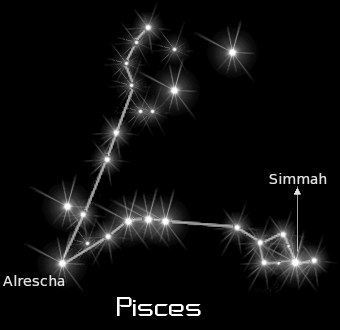Constellation: Pisces
- Kurt Carlo
- Jan 16, 2018
- 3 min read
Pisces constellation lies in the northern sky. Its name means “the fish” (plural) in Latin.
Pisces is one of the largest constellations in the sky. It is one of the zodiac constellations, first catalogued by the Greek astronomer Ptolemy in the 2nd century. Its symbol is .
Pisces lies between Aries constellation to the east and Aquarius to the west. The two celestial fish represent Venus and Cupid in Roman mythology, who transformed themselves into fish in order to escape the monster Typhon. The Vernal equinox, the point at which the Sun moves to the northern hemisphere across the equator every year, is currently located in Pisces.
Pisces constellation also contains a number of interesting deep sky objects, among them the face-on grand design spiral galaxy Messier 74 (NGC 628), the Pisces Dwarf galaxy, the double radio galaxy 3C 31, and the colliding galaxy pair Arp 284.
Stars at Pisces
1. Kullat Nunu – η Piscium (Eta Piscium)
Eta Piscium is the brightest star in the constellation. It has an apparent magnitude of 3.62 and is approximately 294 light years distant from the solar system. The star belongs to the spectral class G7 IIIa, which means that it is a yellow giant. It has a faint companion about an arc second away.
Eta Piscium is 316 times more luminous than the Sun and a mass 3.5 to 4 times solar. It is 26 times larger than the Sun.
The star has an unofficial proper name, Kullat Nunu. Nunu is the Babylonian word for “fish,” and “kullat” refers either to a bucket or the cord used to tie the fish together.
2. γ Piscium (Gamma Piscium)
Gamma Piscium is a yellow giant with the stellar classification of G9 III. It is the second brightest star in
Pisces. It has an apparent magnitude of 3.699 and is approximately 138 light years distant. The star is ten times the size of the Sun and 61 times more luminous. It is believed to be about 5.5 billion years old.
The star is part of an asterism called the Circlet of Pisces, which represents the head of the western fish in Pisces constellation.
Gamma Piscium will not be in the Sun’s vicinity for long. The star moves three quarters of an arc second across the sky every year.
3. ω Piscium (Omega Piscium)
Pisces constellation, image: Till Credner
Omega Piscium is a yellow-white subgiant star with the stellar classification of F4IV. It has an apparent magnitude of 4.036 and is approximately 106 light years distant from the Sun. It is the first star to the east of the Circlet of Pisces.
The star is suspected to be a close binary system. If it is a single star, it is 1.8 times more massive than the Sun and 20 times more luminous.
4. ι Piscium (Iota Piscium)
Iota Piscium is a yellow-white dwarf with the stellar classification of F7 V. It has an apparent magnitude of 4.13 and is 44.73 light years distant from Earth. It is larger and more luminous than the Sun.
Iota Piscium is a suspected variable star, and it has two line-of-sight companions.
5. ο Piscium (Omicron Piscium)
Omicron Piscium is a yellow giant star with the stellar classification G8 III. It has an apparent magnitude of 4.26 and is approximately 142 light years distant. In the 1515 Almagest, the star was listed with the proper name Torcularis septentrionalis.
Mythology
Pisces constellation is of Babylonian origin. The Babylonians saw it as a pair of fish joined by a cord. The constellation is usually associated with the Roman myth of Venus and Cupid, who tied themselves with a rope and transformed into fish to escape the monster Typhon. The star Alpha Piscium, also known by the traditional name Alrescha (“the cord” in Arabic) marks the knot of the rope.
The constellation is associated with a similar story in Greek mythology. After the Olympian gods had defeated the Titans and the Giants, Gaia, or Mother Earth, coupled with Tartarus, the region of the Underworld where Zeus held the Titans imprisoned, and they had Typhon, the scariest monster the world had ever seen. Typhon had a hundred dragon’s heads, with fire blazing from all his eyes.
Gaia sent Typhon to defeat the gods. Pan was the first to see him coming.
He alerted the other gods and then transformed himself into a goat-fish and jumped into the river Euphrates to escape the monster. The goat-fish is represented by the constellation Capricornus.
The goddess Aphrodite and her son Eros called to the water nymphs for help and jumped into the river. In one version of the legend, two fishes came to the rescue and carried Aphrodite and Eros on their backs to safety. In another version, the mother and son were themselves transformed into fish.
Reference:
https://www.wpclipart.com/space/constellations/charts/charts_4/pisces_black.png.html
https://www.shutterstock.com/video/clip-19478491-stock-footage-pisces-constellation-on-a-beautiful-starry-night-background.html
http://www.crystalinks.com/pisces.html
http://www.constellation-guide.com/constellation-list/pisces-constellation/
















Comments